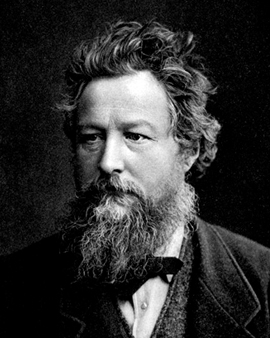


William Morris was born in 1834 in Walthamstow near London, England. He came from a wealthy family. His father worked at the stock exchange and left him a considerable inheritance. His field of activity was not only painting. He also devoted himself to poetry, arts and crafts and architecture.
His parents sent him to a boarding school and, inspired by English Anglo-Catholicism, he initially intended to become a servant of the Church. However, he soon abandoned this idea and went to Oxford University instead. He was very interested in medieval history and architecture, although he was not particularly impressed by the rest of the knowledge or the way it was taught. In Oxford he also made the acquaintance of Edward Burne Jones, later famous for its pre-Raphaelite painting. Morris and Burne-Jones were to become lifelong friends. Through Burne-Jones, Morris also came into contact with John Ruskin, a painter, writer and art historian. Morris also met regularly with the British poet and painter Dante Gabriel Rossetti and the English architect Philip Webb, who created the Arts & Crafts Architecture.
In the circle of this society he also met his future wife Jane, whose graceful, dreamy appearance often served as a model for future portraits of Morris but also Dante Gabriel Rossetti. Dante Rossetti was no less taken with her beauty. Jane gave Morris two daughters. In 1856 Morris moved with the family to London. His apartment was furnished in a Spartan style. Because there was no furniture, a local carpenter was hired to make it. It was Rossetti's idea to decorate this furniture with his own designs. From this idea, which was actually only supposed to be an original makeshift solution, the company Morris & Co was founded in 1861, whose focus was on handicraft.
Morris was a nature lover. Delicate flowers and birds adorned his colourful, sophisticated decorations and veiled his at times slightly choleric temperament. His company expanded even further, producing carpets, wall hangings and wallpaper. Morris dedicated himself to this work until his death, but still found the time to engage in the art of carpet knotting and to pursue his passion for writing poems and legends. He died in 1896. His grave is in Oxfordshire, England, near his summer home Kelmscott Manor, which has been converted into a museum.

William Morris was born in 1834 in Walthamstow near London, England. He came from a wealthy family. His father worked at the stock exchange and left him a considerable inheritance. His field of activity was not only painting. He also devoted himself to poetry, arts and crafts and architecture.
His parents sent him to a boarding school and, inspired by English Anglo-Catholicism, he initially intended to become a servant of the Church. However, he soon abandoned this idea and went to Oxford University instead. He was very interested in medieval history and architecture, although he was not particularly impressed by the rest of the knowledge or the way it was taught. In Oxford he also made the acquaintance of Edward Burne Jones, later famous for its pre-Raphaelite painting. Morris and Burne-Jones were to become lifelong friends. Through Burne-Jones, Morris also came into contact with John Ruskin, a painter, writer and art historian. Morris also met regularly with the British poet and painter Dante Gabriel Rossetti and the English architect Philip Webb, who created the Arts & Crafts Architecture.
In the circle of this society he also met his future wife Jane, whose graceful, dreamy appearance often served as a model for future portraits of Morris but also Dante Gabriel Rossetti. Dante Rossetti was no less taken with her beauty. Jane gave Morris two daughters. In 1856 Morris moved with the family to London. His apartment was furnished in a Spartan style. Because there was no furniture, a local carpenter was hired to make it. It was Rossetti's idea to decorate this furniture with his own designs. From this idea, which was actually only supposed to be an original makeshift solution, the company Morris & Co was founded in 1861, whose focus was on handicraft.
Morris was a nature lover. Delicate flowers and birds adorned his colourful, sophisticated decorations and veiled his at times slightly choleric temperament. His company expanded even further, producing carpets, wall hangings and wallpaper. Morris dedicated himself to this work until his death, but still found the time to engage in the art of carpet knotting and to pursue his passion for writing poems and legends. He died in 1896. His grave is in Oxfordshire, England, near his summer home Kelmscott Manor, which has been converted into a museum.
Page 1 / 3






